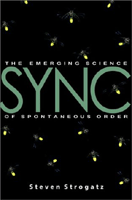Nature's "Eerie Yearning" for Order
April 30, 2003

Book Review
Gilbert Strang
SYNC: The Emerging Science of Spontaneous Order. By Steven Strogatz. Hyperion Books, New York, 2003, 352 pages, $24.95.
This book is about an area of science that touches everyone, even though few have heard of it: synchronization. I think it is destined to be a popular book-partly because it is about people. Steve Strogatz describes a fantastic variety of examples where oscillators get into sync, and in every case he has a story to tell: who observed the oscillators, who did the science, who was affected by the outcome. This review cannot begin to do justice to the variety of phenomena that the book explores, from fireflies to heartbeats to human clocks (and sleep patterns) to Josephson junctions in quantum physics.
One of the nicest parts for me was reading about the way a bunch of scientists, all popping with ideas and probably more than a little competitive, got into sync too. At least that's the story Strogatz tells. I think we all have a natural impulse to impose order on events. Probably this impulse is particularly strong for Strogatz---who chose the theory of synchrony and self-organization for his life's work. (He gave SIAM's Community Lecture in 2001, about small-world networks---which are also explained in SYNC.)
The example he describes first is a perfect choice. Starting with Sir Francis Drake in 1577, visitors to Southeast Asia have seen fireflies put on an amazing show: "Imagine a tenth of a mile of river front with an unbroken line of mangrove trees, with fireflies on every leaf flashing in synchronism. . . . If one's imagination is sufficiently vivid, he may form some conception of this amazing spectacle." Flashing in unison, but how? And why? Philip Laurent (in a 1917 paper in Science) thought it was the twitching of his own eyelids. George Hudson (1918, also in Science) postulated a maestro conducting the other fireflies. Some explanations, Strogatz writes, were "more remarkable than the phenomenon itself!" Gradually, a picture of a crowd of oscillators emerged, each sending and receiving signals, with a tendency to synchronize (and stay that way).
Charlie Peskin recognized a similar synchrony for the pacemaker cells in the heart. We have lots of those cells (in case a few of them start to malfunction), and the firing of each one affects its neighbors. They pace our heartbeat by firing together, and there is a theorem here (Strogatz even outlines a proof). There are also plenty of good open questions. I hope a proposal to the National Science Foundation wouldn't revive a light-hearted 1993 headline from the National Enquirer: "Government blows your tax $$ to study fireflies in Borneo: Not a bright idea!"
Readers of SIAM News will know the name of Strogatz's personal hero. Art Winfree made a crucial link between synchronization in biology and phase transitions in physics---he matched nonlinear dynamics with statistical mechanics. Winfree's death a few months ago was a tragedy for this new science, and Strogatz's moving obituary (SIAM News, January/February 2003) shows how much a single scientist can do. The book explains more about the three-dimensional scroll waves that Winfree proposed as a step toward solving one of the central problems of cardiology---to understand arrythmias and fibrillation (and to find ways to prevent them). Part of this book is about the work of great men of science: Huygens, Wiener, Feynman, Landau. But this is a field to which ordinary mortals have contributed just as much. I hope that description is acceptable to those who are still hard at work (their names are in the book). Steve Strogatz has told their story well.
Gilbert Strang is a professor of mathematics at the Massachusetts Institute of Technology.

